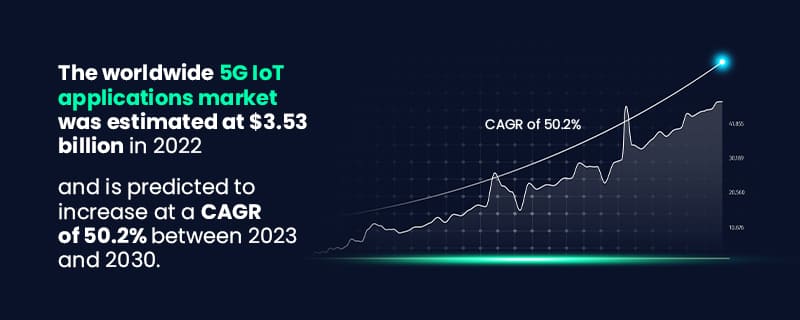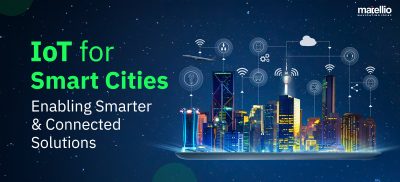
In this blog, we’ll delve deep into the intriguing realm of 5G IoT applications, their significance, use cases, benefits, and much more.
So, let’s get started!
What is 5G and Why It Matters in IoT?
Regarding latency, capacity, and data speed, 5G mobile communication technology performs better than its forerunner, 4G. IoT has a significant impact because of its ability to manage large amounts of data from various devices, including wearables, smart home appliances, industrial machines, and autonomous automobiles. Thanks to real-time interactions and smooth automation made possible by 5 G’s better connectivity, the full potential of IoT applications is unlocked.
5G enhances IoT applications by enabling real-time data processing, boosting responsiveness, and opening up new avenues for innovation thanks to its fast speed and low latency. The 5G era lays out a connected and intelligent future, whether it is for driverless vehicles, smart cities, or industrial automation.
5G for IoT Applications: Key Market Stats!

Moving ahead, let’s discuss,
Benefits of 5G for IoT Applications!
The convergence of 5G and IoT development services has unleashed a host of possibilities, including: –
 1. Ultra-Fast Speeds for Real-Time Applications
1. Ultra-Fast Speeds for Real-Time Applications
IoT enterprise solutions can transmit and receive data in real-time, allowing immediate decision-making and reaction, thanks to 5G’s unmatched speed capabilities. This advantage is significant in applications like driverless vehicles, remote medical procedures, and smart grid systems, where even a small delay might have negative effects.
 2. Massive Device Connectivity
2. Massive Device Connectivity
Compared to earlier generations, 5G technology permits a much greater number of simultaneous connections. As a result, IoT networks can accommodate a sizable number of devices without experiencing performance issues. Infinite possibilities arise from the seamless connection of a wide range of devices, from smart homes and cities to industrial automation.
 3. Low Latency for Enhanced Responsiveness
3. Low Latency for Enhanced Responsiveness
With 5G, latency drastically decreases when sending a command and getting a response. This nearly low latency provides:
- Speedy and effective communication between IoT applications.
- Enhancing the dependability and immersion of applications like real-time monitoring.
- Industrial robots.
- Augmented reality.
 4. Improved Energy Efficiency
4. Improved Energy Efficiency
IoT devices frequently rely on batteries or have constrained power sources. Due to 5G technology’s high energy efficiency, IoT devices can communicate effectively using little power. This benefit helps sustainability efforts by extending gadgets’ battery life while lowering IoT systems’ total energy consumption.
 5. Enhanced Network Reliability
5. Enhanced Network Reliability
The excellent stability of 5G networks ensures constant connectivity even in very crowded areas. In important IoT enterprise solutions like healthcare monitoring systems, intelligent transportation systems, and disaster response, continuous connectivity can be the difference between life and death.
 6. Higher Bandwidth for Richer Data Transmission
6. Higher Bandwidth for Richer Data Transmission
Large amounts of data can be sent smoothly because of the 5G network’s higher bandwidth. High-definition video streaming, virtual reality, and augmented reality (AR) IoT applications require this functionality. The increased bandwidth of 5G can be used by IoT devices to deliver immersive experiences and real-time data visualization.
 7. Accelerated Innovation and Industry Growth
7. Accelerated Innovation and Industry Growth
New business models and creative solutions can succeed by fusing the potential of 5G for IoT applications. The creation of ground-breaking IoT applications across industries, including healthcare, transportation, manufacturing, agriculture, and smart cities, is made possible by the seamless connectivity, low latency, and fast speeds provided by 5G. This fusion of technology opens the door to unheard-of developments, economic expansion, and a higher standard of living.
Also Read- IoT Consulting Services: Everything You Need to Know
Moving ahead, let’s discuss,
Use Cases of 5G IoT Applications!
Now that we have explored the benefits of 5G for IoT applications let’s delve into some of the most compelling use cases that demonstrate the potential of this powerful combination.
1. Smart Healthcare
5G-capable IoT enterprise solutions can transform patient care in the healthcare industry. Thanks to telemedicine, remote consultations, and in-the-moment monitoring of vital signs, doctors can provide quick and specialized healthcare services.
73% of healthcare executives think introducing innovative products and services that enhance people’s quality of life globally would be feasible by the 5G IoT.
5G-powered IoT devices can streamline medical device management, inventory tracking, and drug supply chain systems, ensuring efficient healthcare delivery.
Read More: IoT Healthcare App Development and Solutions: A Comprehensive Guide
2. Industrial Automation
By providing real-time monitoring, control, and optimization of production processes, the combination of 5G and IoT revolutionizes industrial automation. A seamless communication between connected sensors, robots, and machines will increase production, decrease downtime, and improve worker safety.
By 2025, experts predict there’ll be more than 70 billion linked devices, many of which will be used for industrial purposes.
With 5G’s high speeds and low latency, industries can embrace advanced robotics and autonomous systems, unlocking new levels of efficiency and innovation.
5G technology has significantly increased the power of robots and autonomous systems. Production, safety, and efficiency have all significantly increased in industrial processes due to real-time connectivity and machine-to-machine communication. The seamless connectivity that 5G has enabled between robots and machines has enhanced industrial processes, resulting in more efficient operations and better results.
Predictive maintenance is yet another area in which 5G has significantly influenced. 5G facilitates the transfer of real-time data on equipment performance by utilizing the capabilities of Internet of Things (IoT) sensors. This priceless information enables companies to implement proactive maintenance strategies, allowing them to foresee and avoid equipment breakdowns. Organizations Cimprove operational efficiency and guarantee continuous output by reducing expensive downtime.
3. Precision Agriculture
IoT devices with 5G connections can transform the agriculture industry by increasing agricultural yields and resource efficiency. Real-time monitoring of soil conditions, weather patterns, and plant health enables farmers to make data-driven irrigation, fertilizer, and pest management decisions. Precision agriculture boosts productivity, reduces environmental impact, and encourages sustainable agricultural practices.
The agriculture sector has changed digital transformation services, providing many advantages. Livestock monitoring is one use that has profited substantially from 5G. Farmers can precisely monitor their animals’ movements, behaviors, and health thanks to real-time tracking made possible by 5G. As a result, the general welfare of the animals is increased, and agricultural operations are optimized. This capacity enables early illness identification, better animal care, and effective herd management.
Adopting 5G IoT applications has significantly impacted drones and agricultural robotics. 5G increases the precision of critical processes like spraying, planting, and harvesting by providing continuous communication between drones, robotic agricultural equipment, and farm machinery.
Read More: Transform Your Business with IoT Based Smart Agriculture Monitoring System
4. Smart Cities
IoT and 5G technologies converge to create smart, connected cities, fostering optimized resource management, increased public safety, and an enhanced quality of life for residents. Cities can achieve these goals by integrating IoT sensors and devices across urban infrastructure. Smart lighting is an exemplary application of 5G-powered IoT, transforming cities into effective, sustainable, and livable areas. Additionally, waste management systems, parking options, and public transit networks further exemplify the benefits of this integration.
5. Enhanced Retail Experiences
Retail IoT devices equipped with 5G capabilities offer customized shopping experiences and enable effective supply chain management. For instance, smart shelves with sensors constantly monitor inventory levels, minimizing examples of out-of-stock situations and ensuring frames are well-stocked.
Following are some ways in which 5G for IoT applications revolutionize the retail industry: –
1. Improved Customer Experiences
Just imagine walking into a store where you are greeted with personalized suggestions that are presented on digital signs right away and are based on your interests and past purchases. This is becoming a reality thanks to 5G for IoT applications. Retailers can collect real-time data and offer personalized consumer experiences by utilizing the potential of 5G networks and linked IoT devices.
IoT-enabled smart shelves will automatically identify when a product is running short on a stock and provide prompt messages to shop employees, ensuring that your favorite things are always accessible. Additionally, 5G-enabled interactive touchscreen displays and give extensive product information and even virtual try-on experiences, making shopping more enjoyable and convenient.
2. Revolutionizing Supply Chain Management
The retail industry’s supply chain is its foundation, and any interruption will have serious repercussions. This is where 5G-enabled IoT development services can help. These technologies are revolutionizing supply chain management by increasing its agility and efficiency through seamless communication.
Retailers can see real-time inventory levels, temperature control, and transportation conditions by putting IoT sensors and 5G-capable devices across the supply chain. Using this data, they can identify logistical bottlenecks and make data-driven decisions that’ll improve the supply chain. The outcome? Quicker delivery times, less waste, and ultimately lower costs for customers and merchants.
Also Read- Telecom Analytics: Revolutionizing Business Connectivity
Challenges of Implementing 5G for IoT Applications
While integrating 5G and IoT offers immense potential, several challenges must be addressed for successful implementation. Let’s explore these challenges in detail:
1. Network Infrastructure
You’ll need to collaborate with best technology consulting services in order to adopt 5G for IoT applications, one of which is the requirement for a strong network infrastructure. 5G networks rely on a dense network of tiny cells for high-speed connection.
2. Spectrum Availability
For 5G networks to fulfill the promised speeds and capabilities, they need access to various frequency bands, often known as spectrum. Spectrum allocation and availability, however, might differ from one nation to another and can be a difficult procedure. It includes balancing various use cases, regulatory agencies, and current spectrum holders.
Governments and regulatory agencies are attempting to allot extra spectrum for 5G networks to address this issue.
3. Security and Privacy
Security and privacy are becoming major issues in the IoT ecosystem due to the rise of linked devices. With billions of devices likely to be connected by 5G networks, possible cyber-attacks will have a huge attack surface. It becomes vital to ensure the security of these gadgets, the data they contain, and the network itself.
You must implement strong security measures throughout the whole IoT ecosystem if you want to overcome this difficulty. Securing your IoT devices and the data they produce requires end-to-end encryption, authentication methods, and frequent security upgrades. Organizations must also emphasize user consent and data protection while adhering to privacy requirements.
4. Interoperability and Standards
Ensuring compatibility across various devices, platforms, and technologies gets more difficult as the IoT ecosystem develops. Integrating many IoT-based enterprise solutions into a harmonious environment without common standards and protocols might not be easy.
Industry alliances and standards organizations are collaborating to provide common frameworks for IoT interoperability to overcome this problem. To enable seamless integration and communication between devices and platforms, organizations should concentrate on implementing widely established standards and utilizing open APIs.
Also Read- IoT Product Development: Use Cases and Development Process
Conclusion
Incorporating 5G technology into IoT applications has several advantages, opens up new use cases, and poses some significant hurdles. Ultra-fast data transmission rates, minimal latency, higher device capacity, and improved network dependability are among the main advantages of 5G for IoT applications. These benefits open the door for revolutionary solutions in various sectors, including healthcare, transportation, manufacturing, and smart cities.
However, there are also significant difficulties that must be resolved along with the advantages. The main issues with implementing 5G for IoT applications are the need for infrastructure, privacy and security concerns, interoperability and standards, network congestion, and power consumption.
Matellio stands out as a leading provider of IoT development services, offering cutting-edge solutions specifically catered to the particular needs of enterprises. We provide complete services, such as IoT technology consulting services, solution architecture, application development, and system integration, thanks to our expertise in IoT development services.
Accept the possibility of 5G for IoT and work with Matellio to start your IoT journey successfully.
 1. Ultra-Fast Speeds for Real-Time Applications
1. Ultra-Fast Speeds for Real-Time Applications 2. Massive Device Connectivity
2. Massive Device Connectivity 3. Low Latency for Enhanced Responsiveness
3. Low Latency for Enhanced Responsiveness 4. Improved Energy Efficiency
4. Improved Energy Efficiency 5. Enhanced Network Reliability
5. Enhanced Network Reliability 6. Higher Bandwidth for Richer Data Transmission
6. Higher Bandwidth for Richer Data Transmission 7. Accelerated Innovation and Industry Growth
7. Accelerated Innovation and Industry Growth




